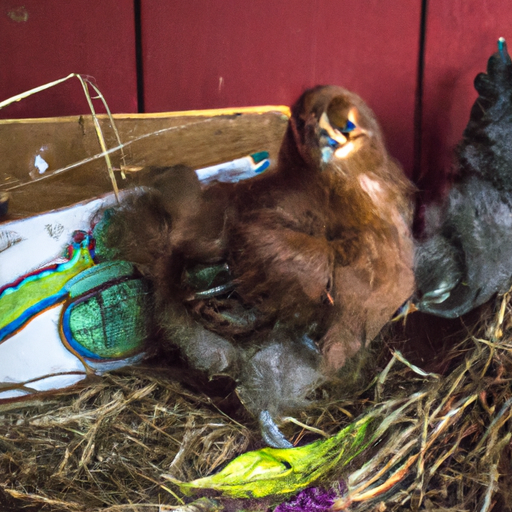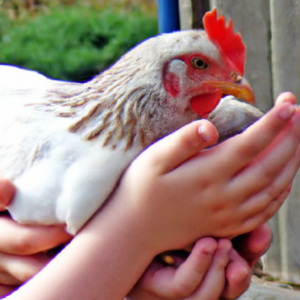
Have you ever wondered about the best way to introduce a chicken to a broody hen? Well, fear not, because we’ve got you covered! Introducing new members to a flock can sometimes be a tricky process. However, when it comes to introducing a chicken to a broody hen, there are a few key strategies that can help ensure a smooth transition. In this article, we will explore some tried and tested methods that will help you successfully introduce a new chicken to a broody hen without causing any unnecessary stress or conflicts. So, if you’re ready to learn the secrets to a seamless introduction, keep reading!
Preparing the Broody Hen for Introducing a Chicken
Ensuring the Broody Hen is Ready
Before introducing a new chicken to a broody hen, it is crucial to ensure that the broody hen is ready for the introduction. One way to determine this is by observing her behavior. A broody hen will display certain signs such as spending most of her time in the nest, being protective of the nest, and showing aggression towards anyone who approaches the nest. These behaviors indicate that she is ready to raise chicks.
Another important factor to consider is the broody hen’s health and condition. It is essential to provide her with a clean and comfortable nesting environment. Make sure the nest is filled with clean and fresh straw or shavings, and regularly clean out any soiled bedding. Additionally, ensure that the hen has access to a nutritious diet and fresh water to support her during the rearing process.
Creating a Comfortable Environment
Creating a comfortable environment for the broody hen is crucial for a successful introduction. Provide her with a quiet and secure space where she can nest without disturbances. It is also important to ensure that the nesting area is free from drafts and is well-insulated. This will help the hen maintain a consistent temperature for the eggs or chicks.
To further enhance the comfort of the broody hen, you can add a dust bath area nearby. A dust bath not only helps keep the hen clean but also provides her with a form of relaxation and entertainment. Use a shallow container filled with fine sand or dry soil, and ensure that it is easily accessible for the hen.
Providing Adequate Nutrition and Hydration
Proper nutrition and hydration are essential for the health and well-being of both the broody hen and the new addition. Ensure that the broody hen has access to a balanced diet containing high-quality poultry feed. Supplement her diet with fresh fruits, vegetables, and protein-rich treats to provide additional nutrients.
Additionally, it is important to provide the broody hen with ample clean water. A broody hen may not leave the nest frequently, so placing a water container near her nest is advisable. Check the water regularly to ensure it is clean and refill it as needed.
Choosing the Right Chicken to Introduce
Selecting a Suitable Chicken Breed
When selecting a chicken to introduce to a broody hen, it is important to consider the breed. Opt for a breed that is known for its broodiness and mothering instincts. Some common broody breeds include Silkies, Orpingtons, and Cochins. These breeds have a natural inclination to sit on eggs and care for chicks, making them ideal for introducing to a broody hen.
Considering Age and Size
Age and size are important factors to consider when introducing a chicken to a broody hen. It is generally best to introduce a chick that is around 1-2 days old. This ensures that the chick is small enough to be accepted by the broody hen without triggering any aggression. Older chicks or adult chickens may not be accepted as readily and can cause conflicts within the flock.
Additionally, consider the size of the new chicken in relation to the broody hen. If possible, choose a chicken that is similar in size or slightly smaller than the broody hen. This will help minimize any potential dominance issues or aggressive behavior during the introduction.
Observing Temperament and Health
Observing the temperament and health of the new chicken is crucial to ensure a successful introduction. Choose a chicken with a calm and gentle temperament, as overly aggressive or skittish chickens may not be accepted by the broody hen.
Furthermore, make sure the new chicken is in good health. Look for bright eyes, clean feathers, and active behavior. Avoid introducing chickens that show signs of illness or have any visible injuries, as this can jeopardize the health of both the broody hen and the new addition.
Introducing the Chicken to the Broody Hen
Planning the Introduction
Proper planning is essential when introducing a chicken to a broody hen. Start by selecting a suitable time and location for the introduction. It is recommended to introduce the new chicken during the evening when the broody hen is relatively calm and settled for the night.
Choose a neutral location for the introduction, such as a separate pen or temporary enclosure. This will prevent any territorial disputes that may arise in the existing coop or chicken run. Ensure that the new chicken has enough space to move around comfortably, but keep it close enough to the broody hen to allow for interaction.
Observing the Broody Hen’s Behavior
As the introduction takes place, closely observe the broody hen’s behavior. Ideally, she should initially display curiosity towards the new chicken without any signs of aggression. A broody hen may peck or vocalize towards the new chicken as a way of establishing her dominance. However, excessive aggression, such as continuous pecking or attempts to injure the new chicken, should be intervened promptly to prevent harm.
Monitoring the Interaction
Continue monitoring the interaction between the broody hen and the new chicken for the first few days. Ensure that the broody hen is accepting and caring for the new addition. The broody hen may guide the new chicken to feed and drink, and she may even sit on the new chicken to keep it warm. This behavior is normal and a positive sign that the introduction is going well.
However, if any signs of distress or aggression persist, it may be necessary to separate the broody hen and the new chicken temporarily. Gradually reintroduce them once both chickens have settled and are displaying more positive behaviors towards each other.
Alternative Methods of Introducing a Chicken to a Broody Hen
Using a Broody Breaker Method
In certain situations, a broody hen may not be accepting of a new chicken or display excessive aggression. In such cases, using a broody breaker method can be considered. This method involves removing the broody hen from her nest and temporarily isolating her in a separate cage or enclosure without nesting materials.
The broody breaker method helps break the broody cycle and reduces the broody hen’s attachment to the nest. After a few days of isolation, reintroduce the broody hen to the existing flock or introduce a new chicken to her. This method can help reset the broody hen’s behavior and increase her acceptance of the new addition.
Utilizing a Broody Hen Foster Program
A broody hen foster program involves transferring fertilized eggs or newly hatched chicks to a broody hen that is already caring for her own chicks. This method takes advantage of the broody hen’s natural instincts and allows her to adopt and care for additional chicks.
To utilize this method, carefully introduce the new eggs or chicks to the broody hen while she is still in the nest. Ensure that the eggs or chicks are similar in size and age to her existing brood. Gradually integrate the new additions and monitor the broody hen’s behavior to ensure the successful integration.
Using a Broody Hen Sitter
Another alternative method is to use a broody hen sitter. This involves temporarily removing the broody hen from her nest and replacing her with another broody hen that is already sitting on eggs or caring for chicks. The substitute broody hen takes over the nest and provides care for the eggs or chicks, allowing the original broody hen to take a break.
Introducing the original broody hen to a new chicken can be simpler when she is not actively brooding. Once the introduction is successful, return the broody hen to her nest, and she will resume caring for the new chicken as part of her brood.
Ensuring Successful Integration
Providing Adequate Space
Providing adequate space is crucial for successful integration between the broody hen and the new chicken. Ensure that both chickens have enough space to move around comfortably without feeling crowded or stressed. If introducing more than one new chicken, provide additional space to prevent overcrowding and potential conflicts.
If possible, create separate areas within the coop or chicken run using temporary enclosures or wire mesh panels. This allows the broody hen and the new chicken to gradually become familiar with each other’s presence and establish hierarchies without direct contact.
Avoiding Overcrowding
Overcrowding can lead to increased stress and aggression among chickens, which can hinder successful integration. If you have a large flock, it is important to monitor the number of chickens in the coop or chicken run and ensure that there is ample space for each individual.
Consider the size of the coop or chicken run and the recommended space requirements for the breed of chickens you have. If necessary, provide additional space or consider expanding the living area to accommodate the broody hen and the new chicken.
Ensuring Sufficient Roosting Spots
Roosting spots are essential for chickens to rest and sleep comfortably. Make sure there are enough roosting bars or platforms available for all the chickens, including the broody hen and the new chicken. Each chicken should have sufficient space to perch comfortably without feeling cramped.
Monitor the interactions during roosting time to ensure that the broody hen and the new chicken are accepted by the existing flock. If any aggressive behavior arises during roosting, it may be necessary to separate them temporarily or rearrange the roosting area to reduce conflicts.
Common Challenges and Solutions
Aggression between Chickens
Aggression between chickens can occur during the introduction process or after the broody hen has accepted the new addition. Address this issue by intervening and separating aggressive individuals if necessary. Provide visual barriers or temporary enclosures to prevent direct contact between aggressive chickens while allowing them to become accustomed to each other’s presence.
Implementing diversion tactics, such as providing plenty of entertainment and distractions, can help redirect their focus and reduce aggression. Additionally, ensuring that there are sufficient resources, such as food, water, and nesting spaces, can minimize competition and aggression within the flock.
Rejected Introductions
Sometimes, despite careful planning, a broody hen may reject the new chicken. If this occurs, it is important to act promptly to ensure the well-being of both chickens. One solution is to remove the new chicken, allow the broody hen to continue caring for her existing brood, and consider alternative methods of introducing a chicken to a broody hen.
Alternatively, you can try reintroducing the new chicken at a later time, either when the broody hen is less protective or when the new chicken is older and larger. Monitor the behavior closely and be prepared to intervene if any aggression arises.
Broody Hen Abandoning Chicks
In rare cases, a broody hen may abandon her chicks or show signs of neglect. This can be heartbreaking, but there are several steps you can take to ensure the survival and well-being of the chicks. First, provide immediate care for the abandoned chicks by providing warmth, food, and water.
To prevent future abandonment, consider removing the broody hen from the flock and raising the chicks separately under a brooder or heat lamp. This will ensure that the chicks receive consistent care and attention until they are old enough to integrate with the rest of the flock.
Gradual Introduction Techniques
Using a Wire Pen Method
The wire pen method involves creating a temporary pen within the existing coop or chicken run. This pen allows the broody hen and the new chicken to interact and become familiar with each other’s presence without direct contact. The wire allows visual and auditory interaction while providing a physical barrier to prevent aggression.
Gradually increase the time the broody hen and the new chicken spend together in the wire pen, closely monitoring their behavior. Once they have become accustomed to each other, remove the wire pen and allow them to integrate into the existing flock.
Introducing through a Partition
Partitioning involves creating a physical barrier within the coop or chicken run to separate the broody hen and the new chicken. This can be done using temporary fencing, chicken wire, or solid dividers. The partition allows the two parties to see and hear each other while preventing physical interactions.
Over time, slowly reduce the size or remove the partition altogether, allowing the broody hen and the new chicken to gradually interact. This method helps minimize aggression and establishes a gradual integration process.
Using a Visual Barrier Method
The visual barrier method involves using opaque or partially transparent barriers to limit direct visual contact between the broody hen and the new chicken. This can be achieved by using temporary walls made of cardboard, fabric curtains, or opaque plastic sheets.
The visual barrier allows the broody hen and the new chicken to become familiar with each other’s presence without provoking aggression. Over time, gradually reduce or remove the visual barriers, allowing the broody hen and the new chicken to interact directly.
Tips for a Smooth Integration Process
Gradually Introducing New Additions
To ensure a smooth integration process, it is important to introduce new additions gradually. Whether it is a new chicken or a broody hen, allowing them time to become familiar with their surroundings and meet the existing flock in small, controlled interactions can minimize stress and aggression.
Monitoring Hygiene and Cleanliness
Maintaining good hygiene and cleanliness in the coop or chicken run is essential during the integration process. Regularly clean the nesting areas, roosting spots, and feeding areas to prevent the buildup of droppings and potential disease transmission. Provide clean and fresh bedding regularly, ensuring that it is dry and free from mold or mildew.
Providing Entertainment and Distractions
To alleviate stress and tension during the integration process, provide entertainment and distractions for the chickens. Scatter food treats or hang vegetable or protein-rich treats to keep them engaged and occupied. This can help redirect their focus and reduce aggression towards each other.
Benefits of Introducing a Chicken to a Broody Hen
Natural Incubation and Rearing
Introducing a chicken to a broody hen allows for natural incubation and rearing of chicks. The broody hen will provide warmth, protection, and guidance to the new addition, fostering natural behaviors and instincts essential for the chicks’ development.
Developing Natural Chicken Behaviors
By introducing a chicken to a broody hen, the new addition has the opportunity to learn and develop natural chicken behaviors through observation and interaction. These behaviors include foraging, dust bathing, and socializing, which are crucial for a chicken’s overall well-being.
Strengthening the Broodiness Instinct
Introducing a chicken to a broody hen strengthens the broodiness instinct in both chickens. The broody hen’s natural inclination to care for and protect her brood is reinforced, while the new chicken learns from the broody hen’s example, potentially becoming a broody hen herself in the future.
Conclusion
Introducing a chicken to a broody hen requires careful planning, observation, and patience. By ensuring that the broody hen is ready and creating a comfortable environment, the introduction process can be smoother. Choosing the right chicken breed, considering age and size, and observing temperament and health are crucial for a successful integration.
Alternative methods such as using a broody breaker method, utilizing a broody hen foster program, or employing a broody hen sitter can be effective in certain situations. Providing adequate space, avoiding overcrowding, and ensuring sufficient roosting spots are vital for the well-being of both the broody hen and the new chicken.
While challenges may arise during the integration process, gradual introduction techniques such as the wire pen method, introducing through a partition, and using a visual barrier can help minimize aggression and facilitate a successful integration. Remember to monitor hygiene and cleanliness, provide entertainment and distractions, and gradually introduce new additions to promote a smooth integration process.
Introducing a chicken to a broody hen offers benefits such as natural incubation and rearing, the development of natural chicken behaviors, and the strengthening of the broodiness instinct. With careful planning, observation, and the right techniques, introducing a chicken to a broody hen can be a rewarding and successful experience for both chickens.







